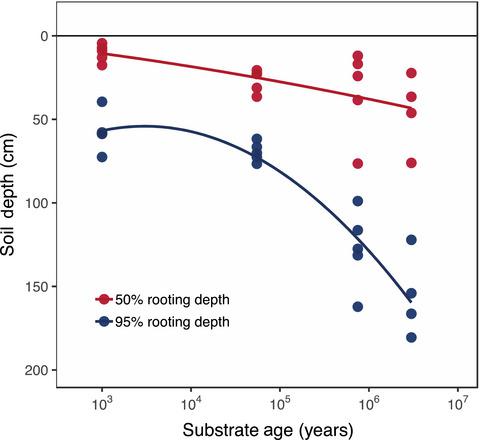Our official English website, www.x-mol.net, welcomes your
feedback! (Note: you will need to create a separate account there.)
The expanding role of deep roots during long‐term terrestrial ecosystem development
Journal of Ecology ( IF 5.3 ) Pub Date : 2020-06-02 , DOI: 10.1111/1365-2745.13444 Gregory S. Newman 1, 2 , Ashley A. Coble 3 , Kristin E. Haskins 4 , Andrew L. Kowler 5 , Stephen C. Hart 6
中文翻译:

深层根在长期陆地生态系统发展中的作用日益扩大
更新日期:2020-06-02
Journal of Ecology ( IF 5.3 ) Pub Date : 2020-06-02 , DOI: 10.1111/1365-2745.13444 Gregory S. Newman 1, 2 , Ashley A. Coble 3 , Kristin E. Haskins 4 , Andrew L. Kowler 5 , Stephen C. Hart 6
Affiliation

|
- Models of ecosystem development and response to environmental variation must incorporate change in vertical soil space as well as over time. Insufficient measurement of subsurface soil properties represents a major observational bias in ecosystem studies.
- We address these changes in horizontal (time) and vertical (soil profile) space along a three‐million‐year, semi‐arid, piñon‐juniper woodland substrate age gradient with characteristic progressive and retrogressive ecosystem development phases and a shift from nitrogen (N) and water to phosphorus (P) limitation. We present a novel pedological approach using isotopic tracers and biogeochemical analyses to address fine root distribution, depth of plant uptake and relative nutrient availabilities.
- We show that (a) the quantity of fine roots remains constant with ecosystem development but their distribution in the soil profile becomes increasingly deeper and less concentrated in the surface soil; (b) mean depth of tree uptake becomes deeper with substrate age and follows the relative availability of P as P‐limitation develops and (c) soil P transformations in the oldest soil profiles resemble the theoretical changes with age to produce a depth gradient of relative N and P availability.
- Synthesis. The expanding role of deep roots in this model system is tightly linked to phases of ecosystem development and relative nutrient availability. The inclusion of whole soil profiles is vital to investigating the intersections of biota, soil and geologic substrate and developing a more complete understanding of ecosystem structure and function.
中文翻译:

深层根在长期陆地生态系统发展中的作用日益扩大
- 生态系统发展和对环境变化的响应模型必须纳入垂直土壤空间以及随时间的变化。地下土壤特性的测量不足代表了生态系统研究中的主要观察偏差。
- 我们研究了三百万年的半干旱,松柏林林地底物年龄梯度,生态系统的发展阶段和回归阶段以及氮素的变化,探讨了水平(时间)和垂直(土壤剖面)空间的这些变化。 )和水对磷(P)的限制。我们提出了一种使用同位素示踪剂和生物地球化学分析来解决细根分布,植物吸收深度和相对养分利用率的新颖的方法学方法。
- 我们发现:(a)细根的数量随着生态系统的发展而保持不变,但是它们在土壤剖面中的分布越来越深,而在表层土壤中的分布却越来越少;(b)树木吸收的平均深度随着基质年龄的增长而变深,并且随着P限制的发展而遵循P的相对可用性;(c)最老土壤剖面中的土壤P转换类似于理论上随年龄的变化,从而产生相对的深度梯度N和P的可用性。
- 综合。深层根系在该模型系统中的扩展作用与生态系统发展和相对养分供应的各个阶段紧密相关。包括整个土壤剖面对于调查生物区系,土壤和地质基质的相交以及对生态系统的结构和功能有更全面的了解至关重要。











































 京公网安备 11010802027423号
京公网安备 11010802027423号